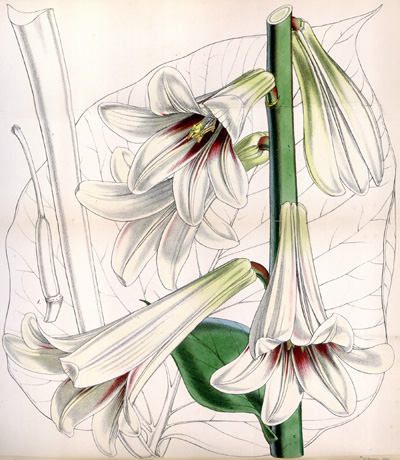|
Cardiocrinum
giganteum - by Harold McBride |
|
| |
|
Cardiocrinum
giganteum, the giant lily, is a native of the Himalayas where it is found
growing in wet forests at 1600- 3500m, flowering in late
June or July.
A variant from western China, var Yunnanense has somewhat
shorter, almost black stems and the new young leaves are bronze
in colour.
|
|
This giant lily is easily grown in moist humus- rich
soil. I find it responds to a deep mulch of leaf mould in early
winter and several liquid feeds after growth
commences. |
|
Growth commences in early spring and the emerging buds may be
damaged by frosts and care must be taken to avoid damage by
slugs. Later plants may be subject to attacks by lily beetle
which is a fairly new pest in Northern Ireland gardens. |
|
|
|
|
|
|
| |
|
 |
| Drawing by Walter
Hood Fitch, in Curtis's Botanical Magazine v. 78
(1852) |
|
I find this giant lily sets copious amounts of seed which ripens
in September, and while it will germinate in its first
spring it does not reach flowering size for 6 to 8 years. This
method of propagation is only for the most patient of gardeners
!
The flowering stems of C. giganteum reach 2 to 4 m in my
garden, and when it flowers its wonderful scent reaches all my
neighbours on a gentle evening breeze, bringing lots of
requests for a closer look !.
|
| C.
giganteum is monocarpic but in the years before
flowering it produces many rooted side shoots which can be
replanted & should reach flowering size in 2/3 years.
|
I have been growing this plant for over four decades and each
spring I look forward to seeing the new buds emerging
through the the deep mulch I have provided and of course
with the promise of such delights to follow .
We as gardeners often complain about the damage
excess rain can do to our plants; however the giant lily thrives
in areas of high rainfall and recently I heard it has
become naturalised in New Zealand, no doubt enjoying the
temperate climate and high rainfall in its new
home .
|
|
|
|
|
|
|